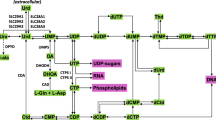Abstract
The antitumor ribonucleoside analogues 1-(3-C-ethynyl-β-d-ribo-pentofuranosyl)cytosine (ECyd) and 1-(3-C-ethynyl-β-d-ribo-pentofuranosyl)uracil (EUrd), first synthesized in 1995, have strong antitumor activity against human cancer xenografts without severe side effects. Here, we studied the antitumor mechanisms of ECyd and EUrd using mouse mammary tumor FM3A cells in vitro and the mechanism of selective cytotoxicity of ECyd using human tumor xenografts in nude rats in vivo. In FM3A cells, ECyd and EUrd were rapidly phosphorylated to ECyd 5′-triphosphate (ECTP) and EUrd 5′-triphosphate (EUTP), which strongly inhibiting RNA synthesis. Cells treated with EUrd were later found to contain both EUTP and ECTP, and ECTP accumulated as the final product. Probably the uracil moieties of EUrd derivatives were efficiently converted to cytosine moieties in the cells. EUrd and its derivatives were minor metabolites in the cells treated with ECyd, so cytidine forms probably were not converted to uridine forms at the nucleoside or nucleotide stage. The ultimate metabolite of ECyd and EUrd, ECTP, is stable in cultured cells with a half-life of at least 3 days, so ECyd and EUrd are on a “closed” metabolic pathway to ECTP. These characteristics of ECyd and EUrd may be important for their antitumor activity. ECyd had strong and selective antitumor activity against the human tumor xenografts. ECyd-phosphorylating activity (uridine/cytidine kinase) in the xenografts was higher than that in the organs of the rats. This finding may account for the strong activity with mild side effects. ECyd and EUrd may be a new kind of antitumor nucleoside analogue for clinical use.
Similar content being viewed by others
Author information
Authors and Affiliations
Additional information
Received: 8 June 1998 / Accepted: 5 November 1998
Rights and permissions
About this article
Cite this article
Takatori, S., Kanda, H., Takenaka, K. et al. Antitumor mechanisms and metabolism of the novel antitumor nucleoside analogues, 1-(3-C-ethynyl-β-D-ribo-pentofuranosyl)cytosine and 1-(3-C-ethynyl-β-D-ribo-pentofuranosyl)uracil. Cancer Chemother Pharmacol 44, 97–104 (1999). https://doi.org/10.1007/s002800050952
Issue Date:
DOI: https://doi.org/10.1007/s002800050952




